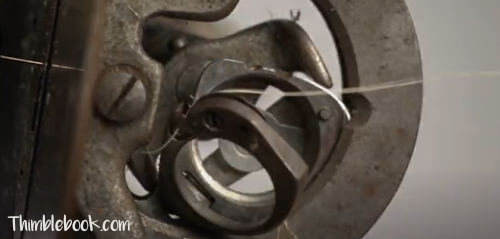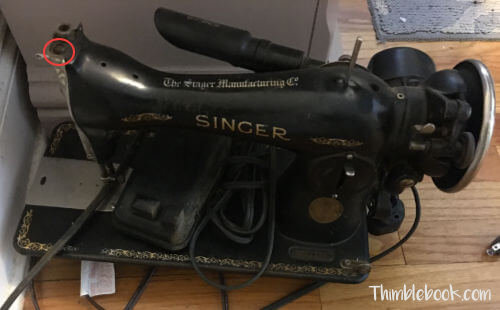Antique Singer Sewing Machine Model 15
*This post may include affiliate links, which allow me to make a small commission off your purchases. The money keeps the website afloat and is earned at no additional cost to you.
Antique Singer Sewing Machine Model 15 was an improved version of the Family sewing machine, which was made in 1879. It remained in production for over a hundred years and saw a number of upgrades during it’s manufacturing life span. The rich history of the 15 makes me so excited to share what I learned during the refurbishing of a 1936 Antique Singer Sewing Machine Model 15-91, which I found at a local thrift store.
Where Do I find Out What Year My Machine Was Made?
For those of you looking for a production year on your Singer 15, try searching ISMACS here. You should be able to find your model there.
Where Is the manual?
The manual can be hard to find because there are so many different versions of the Singer model 15. I’ve listed a few Singer Model 15 manuals below.
How do I know which version of the Antique Singer Sewing Machine Model 15 I own?
Sewing machines often prove themselves to be very much like cars. For example, Honda comes out with a new version of the Honda Civic every year. Therefore, a 1985 Honda Civic looks a lot different than a 2023 Honda Civic. In addition, car brands often offer a base model or a fully loaded version with more features.
The same thing is true from Singer because they changed every few years and offered different base or premium model features . For example, there were base models (hand crank) or fully loaded (treadle machines with the table). Since there are so many different variations, you’ll want to make sure you end up with the correct parts for your specific model # machine. The differences are as follows:
| Dash # | Bobbin Case | Handwheel | Motor |
| 1 | Long beak shuttle | Spoke | Treadle or Hand crank |
| 11 | 1 o’clock bobbin finger 15142 | Spoke | |
| 22 | Long beak shuttle | Spoke | |
| 30 | 1 o’clock bobbin finger 15277 | Spoke | Treadle Or Hand crank |
| 80 | 1 o’clock bobbin finger 15277 | Spoke | |
| 86 | 1 o’clock bobbin finger 15277 | Spoke | Treadle |
| 87 | 1 o’clock bobbin finger 15277 | Solid | Belt driven motor |
| 88 | 11 o’clock bobbin finger | Spoke | Treadle or Electric |
| 89 | 11 o’clock bobbin finger | Spoke | Hand crank |
| 90 | 11 o’clock bobbin finger | Solid | Belt driven motor |
| 91 | 11 o’clock bobbin finger | Solid | Potted Motor |
| 96 | 1 o’clock bobbin finger 15277 | Spoke | Treadle |
| 98 | 1 o’clock bobbin finger 15277 | Spoke | Hand Crank |
| 97 | 1 o’clock bobbin finger 15277 | Solid | |
| 110, 111,112 | 1 o’clock bobbin finger 15277 | Solid | |
| 115 | Rotary hook and class 20 bobbin system | Spoke | Treadle |
| 125 | 11 o’clock bobbin finger | Solid | Potted Motor |
| 75 | 11 o’clock bobbin finger | Solid | Belt Driven Motor |
Out of all the differences, the main thing to concern yourself with is the bobbin case.
Singer frequently changed out bobbin cases on their machines. So, if you need a bobbin case for your machine, you’ll want to make sure it’s the correct one for your model. Some of the bobbins are harder to find than others. But, I ‘ve listed what I could find below.

This is the long beak shuttle bobbin system from Singer 15-1. You certainly wouldn’t have to worry about replacing a bobbin case with this model.
- Long beak shuttle *Its not a bobbin case you need to buy because it’s built into the machine.
- 11 o’clock bobbin finger (Part 125291)
- 1 o’clock bobbin finger
- Part 15142
- Part 15277
- Class 20 bobbin system (Part 55651) * This bobbin is not currently being remanufactured. The closest thing to the correct bobbin is a Singer 20U L shaped bobbin. But, you’ll have to make modifications to the bobbin in order to make it work. Yes, its unfortunate! Here is a link to a forum where they discuss how to make modifications.
Potted Motor
Potted motors are workhorses. But, they are a pain to rehab. Most of the Singer potted motors take a 3/16ths size piece of wool. This wool used to be common in household appliances like fans. Today, however, this wool is very hard to come by. Below, I have listed a source for wool.
Also, the potted motor takes motor brushes and motor brush caps. All of this stuff really adds up in costs. I’ve listed a link to the motor brushes for the Singer 15-91. But, the brush cap is expensive for it just being a piece of plastic. The brush cap is 9.1mm on the threaded end and 12.2mm at the cap end. It is about 1/4 inch long . So, you might be able to use those measurements to find some generic brush caps instead.
Motor Brush Cap #193543 will fit Singer 15-91 and Singer Featherweight 221.

There are wicks other than the motor brush ones…
There is one other wool wick on top of the area where the needle bar sits. This wick is larger than the 3/16’s size wick. But, I just tied one 3/16’s felt cord to another (wrapped it tightly) and crammed it in there because I just didn’t want to pay shipping twice. But, if you find it necessary to buy two different size wicks, then be my guest.
125274 4970 Needle Bar Bushing Oil Pad (felt) for 125273 [ 1/2 in]
In addition to these wicks, you’ll find a braided cotton wick on the bottom of your machine. I used some cotton cording intended for making piping. But, here
Grease For Motor
Also, you are likely to need grease for your motor. Some folks online say it is alright to use Vaseline. But so far, I’ve only used Sew Retro grease.
Foot Control
The foot control for Singer 15-91 is one of the old school kinds ideal for using with an old school knee control. If you prefer to use the foot control in a modern way, you can purchase a modern foot control.

By the way, Singer 15-91 weights 25.6LBS
My Personal Opinion About Antique Singer Sewing Machine Model 15
Positives Thoughts
I think Singer 15 is a very well built straight stitch machine. I love how easy it is to disassemble because many modern machines don’t offer the same luxury. Just by working on the machine, I can tell it was very well made and thought out.
For example, there is a needle bar height line to help users set the needle at the correct height. Also, there is a timing line so you can easily set the machine in the correct timing without going to a service tech. Today, manufacturers definitely don’t show you how to fix a machine to that degree. So, I really do admire the 15.
In addition to the ease of use and repair, Antique Singer Sewing Machine Model 15 has a beautiful straight stitch. Since it has such a beautiful straight stitch, it is ideal for working on quilting and other projects where the stitches are front and center.
Complaint A
After using this sewing machine for a few months I have 3 main complaints. First, this sewing machine is full of flat head screws. I know all vintage screws were flat head. But, flat head screws are a pain in the tail because they get worn down so quickly and become quite difficult to remove. I spent over an hour just trying to remove one screw. When nothing else worked, I drilled out the screw and tapped a new hole.
Complaint B
Before I let you know the second complaint, I have to provide a little background information. Singer 15-91 came in multiple different versions. Versions included:
- Potted motor
- Treadle
- Belted Motor
- Hand crank
The most popular version is the potted motor one because it is slightly more powerful. However, I am not a fan of potted motors because they require non-synthetic grease. The grease melts and cycles thru the motor to keep it running smooth. However, heat and grease cause a number of problems. Problems are as follows:
- When a machine remains unused for a long time, the grease hardens and creates a sticky mess that must be cleaned out. This cleanup processes is not easy because it took hours for me to clean out the machine featured in this blog!
- Grease gets on the rubber handwheel gasket and causes it to degrade over time. (PS: Petroleum based grease does one hell of a number on rubber and/or plastic).
- Wires sit super close to the armature, which heats up to melt the grease. Hence, 9 times out of 10 the wires in these machines have to be replaced. This problem is time consuming to fix. But, it can also become dangerous if not addressed.
Complaint C
Third, the potted motor can burn out over time. I’ve seen this happen a few times and when it does, you either have to replace your burned out motor with another 60+ years old potted motor or build your own. The first option isn’t ideal and the second requires a lot of knowledge. For this reason, I’m not a fan of the potted motor configuration.
Other Helpful Articles
Information About A Featherweight Singer 221 Machine
Little things about Singer 66 Sewing Machine




No Comments